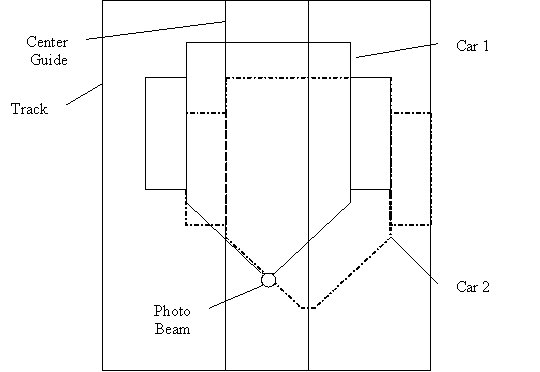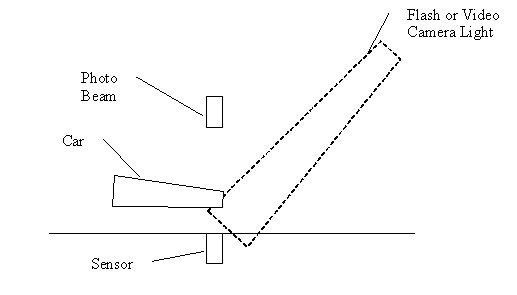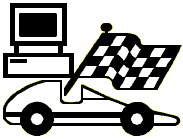|
|
Why we don't use Photocells
Photo beam Problem 1
A competitor (who uses photo beam detection) advertises a resolution
of 0.00001 seconds and guarantees no ties. They completely fail to mention
that the resolution is that of their timer, not that of their sensor (nor
of their display). While their sensor is probably comparably as fast, the
drawing below shows the fallacy of the claim.
In the example, we've used pointed partial cars and a small track segment
for drawing simplicity. You can get around the pointed car problem by not
having pointed cars, but pointed (or rounded) cars are more aerodynamic. By
the way, the competitor also claims, "The smaller the sensor, the greater
the accuracy." This is nonsense unless you are trying to detect a very small
object. The output of any sensor (that is smaller than
the width of the car) switches from
'no car' to 'yes car' at some fairly well-defined point.
By way of analogy, it doesn't matter how big the faucet
is, at some point water either comes out or it doesn't.
Note that Car 1 (solid line) traveling in the center of the lane will break
the beam almost 3/8" sooner than Car 2 (dashed line) traveling
on the edge of the lane. Which one is the winner?
This to-scale drawing also points out an interesting track detail. Whether the track
is center-guided or edge-guided, the car usually has about the same size lane to travel.
It is not possible to say the car has the same size lane in all cases, since there are
at least two commonly published track designs that use different size center guide rails.

Photo beam Problem 2.
Virtually all systems (NOT SUPERTIMER II)
use Infrared (IR) Beams. This is
done partly to restrict interfering light and partly because IR transmitters
and receivers are commonly and inexpensively available. But the warmth you
feel from sunlight is from the IR part of the spectrum. IR is everywhere.
Both flash bulbs and video lights have high
IR energy, especially when compared to the relatively weak IR photo beam.
So the sensor is usually placed in a tunnel and an optical filter is added to
help the problem. But a tunnel and filter only reduce the potential interference, they
don't eliminate it. By way of analogy, you usually can't hear a car on
the street from inside your house, but you can if the car backfires or if
it's a truck. The house filters the sound but it doesn't (can't) eliminate
it.
In the drawing below, a flash camera or video light hits the sensor while the
car is crossing. Note that the car has
broken the 'normal' beam but that the sensor still 'sees' the extra very
bright light. Will you get an answer? Of course. Is it correct?
By the way, the fairly obvious solution of putting the beam below the track and the
sensor above helps but doesn't cure the problem, since IR light bounces fairly well.

|

![[SuperTrack]](/track/pinewood_derby_track_tr1c.jpg)
![[SuperTimer II]](/ssi/pinewood_derby_timer_pw.gif)
![[College]](/ssi/college.gif)
![[home]](/ssi/pinewood_derby_home.gif)

